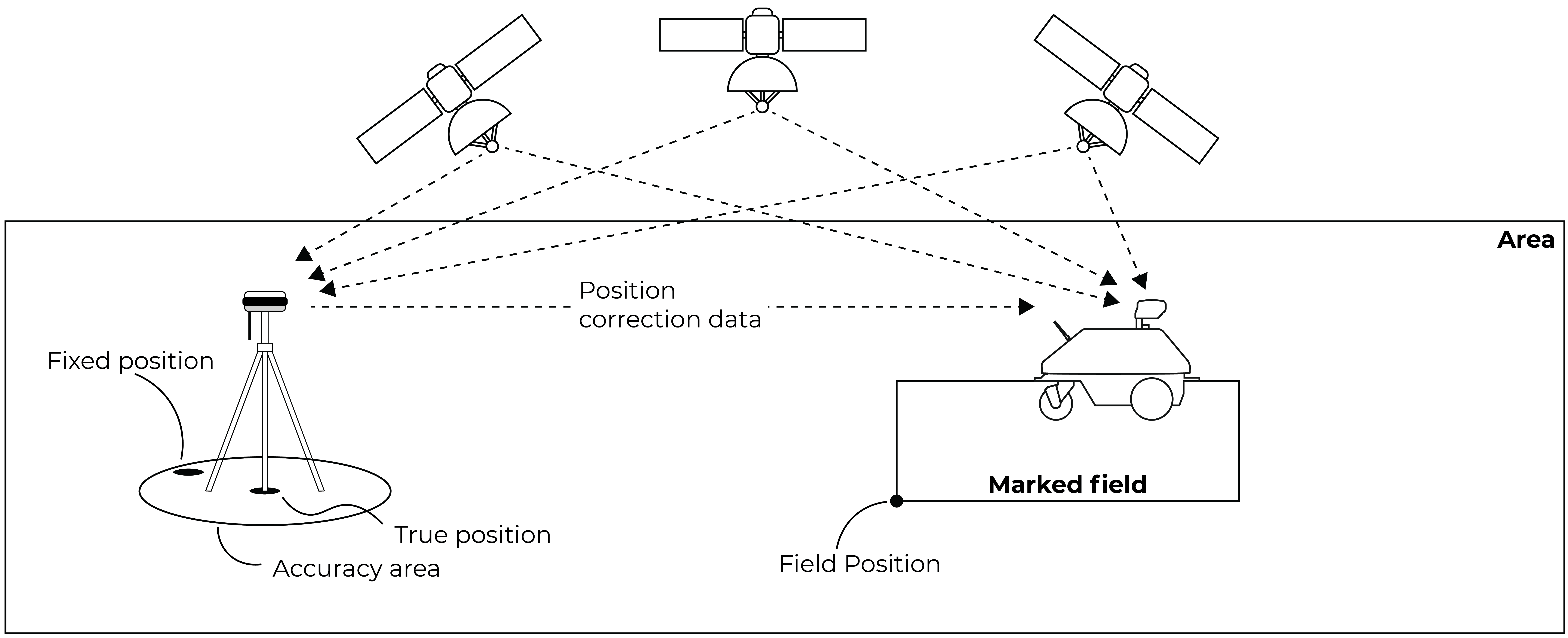# How It Works
This section provides you with an overview of the technologies used to make the Turf Tank One the most accurate line marking machine around.
# How the Turf Tank One navigates
Both the Turf Tank One and the Base Station operates via GNSS (Global Navigation Satellite System) to determine their geographical positions.
A Global Navigation Satellite System consists of multiple satellite constellations, which is a group of artificial satellites working together as a system.
Unlike a single satellite, a constellation can provide permanent global or near-global coverage, such that at any time everywhere on Earth, at least one satellite is visible.
The Turf Tank One supports up to four different satellite constellations (depending on the time of purchase):
GPS(Global Positioning System, USA)GLONASS(Russia)Galileo(Europe)BeiDou(COMPASS/BDS, China)
PLEASE NOTE
All robots and base stations support GPS and GLONASS.
Many also support BeiDou, and units sold from 2020 going forward will most likely support Galileo as well.
Each of the constellations above is biased towards regional coverage, meaning that the American GPS will tend to have more visible satellites above America.
As your Turf Tank One tracks up to four different systems, you should, depending on your geography, always see at least 10-15 satellites.
Tip
The number of visible satellites is, as a general rule of thumb, not an indicator of accuracy. As you dig deeper through the contents of this wiki, you will be presented to other, and better, indicators establishing what accuracy can be expected.
# Real-Time Kinematics (RTK)
For your Turf Tank One to operate at centimeter-level accuracy, it relies on a technology called Real-Time Kinematics, or RTK.
Without RTK, your robot will rely only on raw satellite data, which can only provide an accuracy of approximately 1-2 meters.
This limitation is overcome with the help of the Base Station, which is broadcasting RTK corrections to the robot.
Thus, providing your Turf Tank One with the ability to operate reliably at centimeter-level accuracy.
Attention
Setting up the Base Station does not enable the Turf Tank to operate indoors or below tree canopies.
The Base Station only sends RTK correctional data to the Turf Tank, helping it achieve centimeter-level accuracy while also increasing reliability.
# Why use a Base Station?
At TURF TANK, we want to provide our customers with the best possible conditions for marking great looking fields, and this is the reason we use a Base Station. The purpose of the Base Station is to provide RTK corrections to the Turf Tank One which increases positional precision from approx. 1-2 meters down to +/- 1 centimeter.
As such, the Turf Tank One could be designed to work entirely without the Base Station. Doing so, would require continuously access to what is called a CORS network in order to still achieve centimeter-level precision. CORS stands for Continuously Operating Reference Stations, and is essentially a network of external Base Stations which provides correctional data via wireless communication (e.g. internet, cellular). These CORS networks are either owned by a government or private companies.
Below is a comparision of the two scenarios.
Turf Tank One With Base Station
Advantages:
- High accuracy level is always available (since you have a local reference point to base of)
- No additonal cost implicated.
- Does not require a steady connection to a CORS network.
- Only depends on satellite connection.
Disadvantages
- Requires additional hardware setup (Base Station)
- The Base Station needs to be placed as the exact same spot every time.
Turf Tank One With CORS Network Only
Advantages:
- No local Base Station required.
Disadvantages:
- Accuracy decreases with distance.
- Network coverage varies from region to region and country to country.
- Requires continuously access in order to work.
- Depends on CORS network and satellite connection.
- Requires paid subscription plan.
- TURF TANK does not provide support for CORS network since this is provided through third parties.
# Obtaining a reference point for the Base Station

Before the Base Station can broadcast RTK corrections to the robot, it needs to establish its reference point.
This point is representing the fixed position of the Base Station, which is not necessarily its true position.
As the Base Station uses raw satellite data, it can only obtain a position within the accuracy area (as seen in the image above), which corresponds to approximately 1-1.5 meters.
# True (actual) position vs. fixed position
The accuracy area as illustrated in the image above shows the expected accuracy of the Base Station when relying solely on raw satellite data (which the Base Station does).
When the Base Station initializes it will choose it's reference point (the fixed position), which can be anywhere within the circle.
It is important to note that the fixed position doesn't necessarily have to be the same as the true position (where it is actually positioned on the field).
Please Note
Even though the fixed position does not equal the true position, accuracy of markings will not be affected, as the fixed position is the only thing the robot sees.
The robot doesn't care about the physical location of the Base Station - unless, of course, it has been moved after being initialized.
# Operating the Turf Tank One
When setting up fields and operating the Tank One autonomously, its position is improved by receiving the RTK corrections broadcasted by the Base Station.
This allows for accurate field markings as well as making sure your fields are always being painted where they should.
PRO TIP
If a field shifts unexpectedly, it is often because the reference point of the Base Station wasn't correctly initialized or the Base Station was moved after being initialized.
If this happens, simply re-initialize the reference point with the method of your choice.
